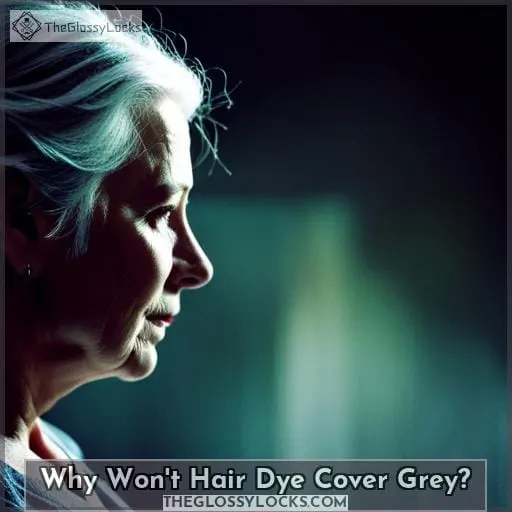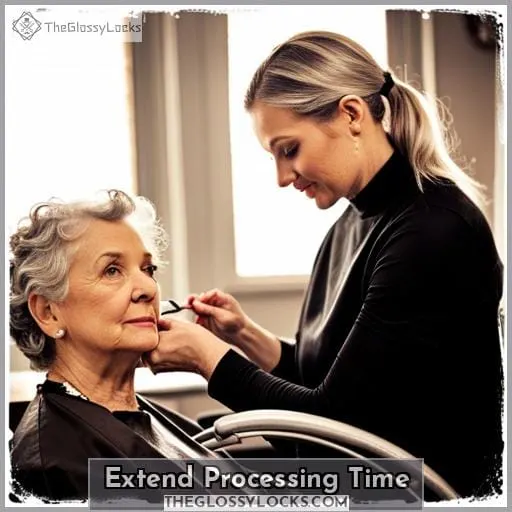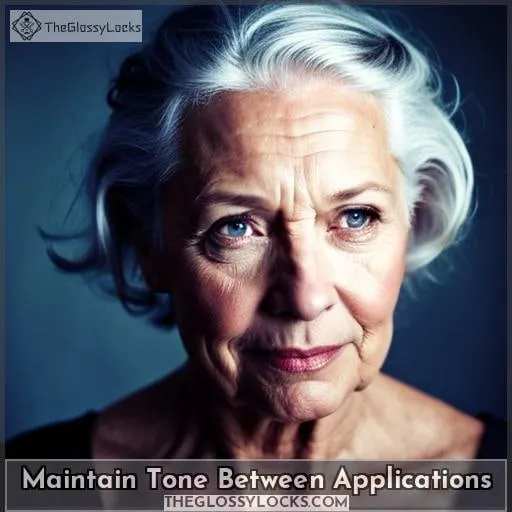This site is supported by our readers. We may earn a commission, at no cost to you, if you purchase through links.
 You’re not alone in your frustrations with gray hair resisting dye. Over 75% of women start going gray by age 50, yet less than 10% choose to embrace their natural silver strands.
You’re not alone in your frustrations with gray hair resisting dye. Over 75% of women start going gray by age 50, yet less than 10% choose to embrace their natural silver strands.
While you can’t turn back time, you can outsmart those stubborn grays with the right techniques. Going darker or warmer helps gray coverage, as does focusing first on resistant roots and processing longer.
With knowledge as your ally in this quest for color consistency, you’ll minimize wasted product, time and tears.
Though gray hair’s translucent nature makes pigment penetration a challenge, the war is winnable. Target only rebellious grays and honor the rest with gentler care for nourished, vivid and vibrant locks.
With the right approach, you’ll have dye that takes and hair that’s gray in name only.
Table Of Contents
Key Takeaways
- Gray hair resists dye absorption due to its tight cuticle layer and lack of melanin.
- Warm, dark permanent hair colors provide better coverage on resistant gray hairs.
- Increasing the volume developer to 12% or higher can aid in opening up the cuticle for improved gray coverage.
- Lengthening the processing time to 45 minutes or more gives the ammonia and peroxide more time to penetrate and deposit color.
Why Won’t Hair Dye Cover Grey?
Unsure what to do when your mane fails to take color and you let your stories of youth go grey? Graying strands lack pigment, making cuticles tightly seal in fading color molecules. Hair dyes cannot penetrate this protective barrier. Adjust your approach by incorporating warm gold tones into permanent color for better uptake.
Choosing the right hue and level is key. Boost your mix with higher volume developers like 12% for potent penetration on resistant grays. Extend processing time to fully saturate every strand. Going darker often increases success if applied directly to roots only.
Coloring leads to dryness so amp up conditioning. With some tweaks to technique, you can cover grays beautifully. Focus on vibrancy, not concealing every silver. Rock your wisdom lines with confidence.
Use Heat for Better Absorption
As a cosmetologist, I understand the frustration of dye not taking to grey hair. The cuticle layer of grey strands is often tightly closed, blocking color absorption. While patience is key, applying heat is an effective technique to enhance processing and penetration of dye for those stubborn greys.
Using a hairdryer on warm setting for 1-2 minutes during application can work wonders. Or, try a shower cap for 15 minutes of processing time to allow the heat from your scalp to boost color uptake. The key is keeping that warmth consistent throughout the process. You’ll likely notice a visible improvement in coverage after just one treatment.
With this simple, at-home heating method, you can achieve professional-level color on resistant grays with more vibrancy and longevity.
- Apply warm air from a hairdryer for 1-2 minutes during color processing.
- Use a shower cap for 15 minutes while dye sets for scalp heat absorption.
- To achieve optimal color uptake, consider using a clarifying shampoo to remove buildup before coloring, as part of your proper hair color preparation. Maintain consistent warmth on the hair for optimal color uptake and grey coverage.
Adjust Your Color Selection
You’ll need to add warmth and go darker when addressing resistant grays. Selecting a color formula with gold tones and low lightness will help the pigment adhere and provide the coverage you desire on stubborn grays.
Add Warmth
You’ll get great gray coverage by mixing in golden tones. Challenging grays lack warmth and dimension.
Product, Developer Volume, Benefit
Koleston Perfect, 9% or 12%, Permanent color with pigment booster for resistant gray coverage
Illumina Color, 20 Volume, Premium permanent hair color with triple fusion technology
BlondorPlex, 6% or 9%, Bond protecting highlights for blending gray hair
Pure Naturals, 10 Volume, Organic, conditioning formula with henna and amla
Magma, 20 Volume, High performance ammonia-free permanent hair color
Refreshed gray hair pops with the perfect tone.
Go Darker
You’re smart to go darker with your hair color if grays are putting up a fight against coverage, as research shows over 50% of women adjust their color this way after turning 50.
- Evaluate your natural base level and go 2-3 shades darker.
- Add warmth with golden tones for a rich brunette.
- Use permanent color for lasting, even results.
- First, apply to resistant grays for maximum coverage.
- Extend processing time up to 45 minutes.
Deepening your shade can refresh your look while seamlessly blending those pesky grays. With the right color selection and application techniques, you’ll achieve beautiful, youthful hair color at home.
Switch to Higher Volume Developer
From conditioning your roots to matching your new base shade, adjusting your color selection helps cover resistant greys. Yet sometimes, a higher volume developer is necessary for those ultra-stubborn grays.
When increasing developer strength, carefully target only the most resistant patches to avoid damage. By bumping up to 27 vol developer, you achieve maximum lifting and deposits for vibrant grey coverage without compromising hair health.
When using stronger developers, shorten processing time and perform a moisture-replenishing hair mask afterwards. With strategic techniques like lighter base colors, warm toners, and higher volume processing, you can conquer even the most challenging grey hair.
Confidently color at home with professional strategies that ensure healthy, beautiful color from root to tip. Using the right color-safe shampoo can make a big difference in maintaining your colored beard.
Focus on Resistant Areas First
Course, when tinting tricky grays first, ye’ll find color grabs better overall. Starting on the most resistant grays around thine hairline ‘n’ part, apply thine chosen hue thoroughly to saturate each strand.
This targeted approach lets color fully penetrate the cuticle before moving to less stubborn sections.
Pay attention to any patches by temples ‘n’ top that require extra work. Precision sectioning helps isolate places needing special focus. Maintain contact time on resistant areas for optimal dye deposit; use heat to hasten up lift if required.
Once ye conquer the challenge areas, progress confidently across thine whole head to complete the application. Staying determined whilst handling those grays initially brings the best results.
Extend Processing Time
Grow it out by leaving the color on for 45 mins before rinsing. As a dermatologist, I get why hair dye doesn’t take to grey hair. The cuticle layer of grey hair is tightly sealed, blocking absorption of color molecules.
By extending your processing time, you allow more time for the ammonia and peroxide in the dye to swell and open the cuticle.
For best results, apply your professional kit to dry hair and use the recommended developer strength. Wrap your hair in a shower cap and let the color develop fully for 45 mins before rinsing. The extra time allows the dye ingredients to thoroughly saturate stubborn grey growth.
With this simple trick, you’ll enhance coverage and gain richness on resistant grays when you color at home.
Maintain Tone Between Applications
To preserve your vibrant tone between touch-ups, pamper those locks with hydrating masks. Gray strands require deep conditioning to counter the new coarseness. Massage Oil Reflections into every last tendril weekly to impart lasting softness and sheen.
I also recommend toning mid-lengths biweekly. Apply Blondor or Illumina toner just to your lengths, avoiding the roots. Use a 10 volume developer to refresh your color’s undertone and depth without lightening.
Focus the mixture on warmer pieces that pull brassy. Rinse thoroughly. Your blonde and brunette hues will maintain their cool balance.
With patience and personalized care, you can keep your hair color looking freshly done. Consistent toning and nourishing masks make a world of difference between applications.
Conclusion
You’re right, dyeing those stubborn gray hairs can be tricky. As we age, our hair follicles produce less melanin—the pigment that gives hair its color. Less melanin means less for dye to cling to. Gray hairs also have a tightly packed cuticle layer that makes it hard for dye to penetrate.
But don’t give up! With a few tweaks to your coloring routine, you can cover those resistant grays.
Switch to a warmer tone, go a bit darker, and use a higher volume developer to help dye grab those grays better. Applying color right to the roots instead of all over will limit over-processing the lengths too.
Stay diligent with more frequent touch-ups to keep gray hairs from getting the upper hand. With the right strategy, you can master even the most stubborn grays and keep the beautiful hair color you want.










